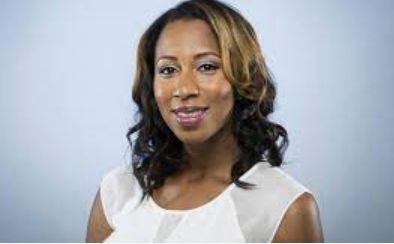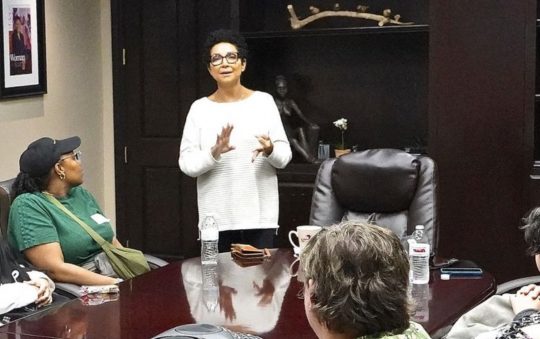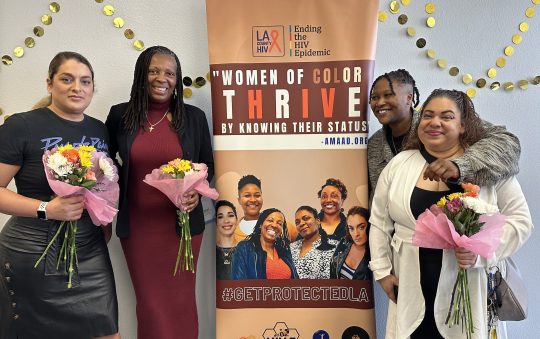
South Los Angeles has changed considerably over the last few decades and those variations were the main topic covered during the panel discussion entitled, “Is South L.A. Forging a New American Identity?”
Zócalo Public Square sponsored the live program, presented both online and in-person, at Mercado La Paloma on July 27, and the dialogue was both enlightening and concerning as the panelists shared how South L.A. evolved from South Central, how the neighborhood transformed from majority White to majority Black to majority Spanish-speaking, and what the future holds for the celebrated area. Angel Jennings, L.A. Times assistant managing editor for culture and talent, moderated the session and kept the audience engaged as she asked a range of thought-provoking questions. Responding to Jennings’ inquiries were panelists Corey Matthews, chief operating officer of Community Coalition; and USC sociologists Pierrette Hondagneu-Sotelo and Manuel Pastor, co-authors of the book, “South Central Dreams.”
Jennings opened by querying the group on the correct designation for the geographical district and Pastor frankly stated, “South Central or South L.A.? There a lot of debate about which name to use.”
Matthews, a L.A. native, said, “South Central is the name we all grew up knowing. It was the name that reflected where we lived at, how we behaved, what we believed. A lot of our music paid homage to South Central and it gave us a sense of pride about where we lived. I left and lived in a couple of other cities and [when I] came back, it was South Los Angeles.
“At first, I felt like I was losing the identity that I called home. South L.A. wasn’t the same any longer. The demographics had shifted so dramatically. In a lot of ways, I am relearning what South L.A. really is,” he said.

Sharing a comparable opinion, Jennings noted, “Right now, there’s this reclaiming happening of the name ‘South Central’ and what that means. There’s a pride that comes with it, a resiliency, a camaraderie that comes with that name.”
Sotelo shared that in interviewing residents for the book, people were asked what they identified as home or where they lived. “One person told me that South Central was a special term of endearment for them. Other people felt that South L.A. was all more encompassing. They felt included using that term.”
Tracing the demographics of the area, Pastor commented, “South L.A. was actually a White working class community as well. A lot of the western part of the region and even Watts had a significant White working class community. A lot of that community moved out, both because of fair housing laws that made it possible for Black people to buy in and White flight after the 1965 Watts rebellion.
“In 1970, South Central was 80% African American and 50% of all Black people in the county lived in what is now South L.A. Today, South L.A. is two-thirds Latino and only one-quarter of the county’s Black population lives in South L.A. People have dispersed and there is a sense of loss on the part of the Black population that this central place of meaning – which had become a sacred space for all of Black Los Angeles – is gone,” said Pastor, who has worked in South L.A. since the 1990s during Mark Ridley-Thomas’ first term as a councilmember and with Karen Bass and the Community Coalition.
Viewpoints about South L.A. inhabitants have changed through the generations, reflected Sotelo. First-generation immigrants tended to have negative impressions of African Americans, likely formed by their “own bubble,” she said, “as monolingual Spanish-speakers, coming with their own color lines from their countries of origin. Their kids have a totally different experience. Their kids are often born here, they’re raised here, they have Black friends, Black teachers and mentors.”

As the presentation neared the end, Jennings asked the panelists what should be the focus in reimagining South L.A. Emphasizing the political aspects, Pastor said that while Latinos are two-thirds of the population, they are only one-third of the voters. Also, 40% of South L.A. Latinos are undocumented and many are young as well. The African American population is 10-to-15-years older than the Latino population in terms of median age.
“I think it’s important to realize that advancing a Latino agenda in South L.A. requires a strong Black political structure because they (Blacks) traditionally advocate for justice, empowerment and inclusion. Strengthening the Latino voice and strengthening the Black political voice is something that has to be done at the same time,” he insisted.
Matthews said his organization elevates a cohesive message around Black-Brown politics and represents what solidarity really is. “We at Community Coalition believe that the power rests with everyday people coming together, knocking on every door and asking them, ‘What is your vision for your community and what do you feel is needed to assert that vision?’ Also, we must focus on housing livability, housing affordability, living wage jobs and student loan debt.”
Offering a similar concern, Sotelo said, “The looming danger is can South L.A. continue to be a home for the residents who are currently here and have been here for several generations.”






